Authority Soccer (authoritysoccer.com) is a participant in the Amazon Services LLC Associates Program, an affiliate advertising program designed to provide a means for sites to earn advertising fees by advertising and linking to Amazon.com. This site also participates in other affiliate programs and is compensated for referring traffic and business to them.
Every time we watch a game of soccer, a team seems like they have an extra player on the field, or the opposition has trouble getting to the penalty box because of players constantly kicking the ball away.
Do we then wonder what formation was the coach playing? There are so many different formations that teams can use based on the players that they have at their disposal.
In this article, we are going to list the top ten best-ranked formations. From ones that are great for attacking football to ones that are great for an out-and-out defensive game and all others in between.
Ultimately is it a matter of opinion so read on to find out which ones we think are the best ten soccer formations to use.
1. The best effective soccer formation – 4-1-4-1

This formation is one that puts a huge amount of importance on having a really solid defense but at the same time, it does not fully limit the ability of the team to attack.
This is a formation that is largely built in the individual strengths of players within the starting eleven. If the team has the right players to play this type of system it provides a really solid formation and will allow the individual talents of the players to come to the floor.
This type of formation is bolstered by its ability to stagger the depths of each of the four lines of player, adding to that, the wings are guarded by both the fullbacks as well as the wingers.
There is a downside to this formation however and that is up forward there is only one striker. The midfield is really compact, and the only really defensive midfielder has two main jobs.
That is to support when the team is playing out from the back and will become part of a four-man midfield and then he can act as an extra body on defense to help protect the back four.
With a back four, the formation is reasonably solid, and it puts a huge amount of pressure on the one holding midfielder as well as the lone striker.
If it is not done right then the striker can be left isolated up in attack and offer nothing going forward and that will then put pressure on the midfield and defenders as the ball is constantly coming back and they will eventually cave in to the pressure of the opposition.
2. The best soccer formation to score goals – 4-3-3
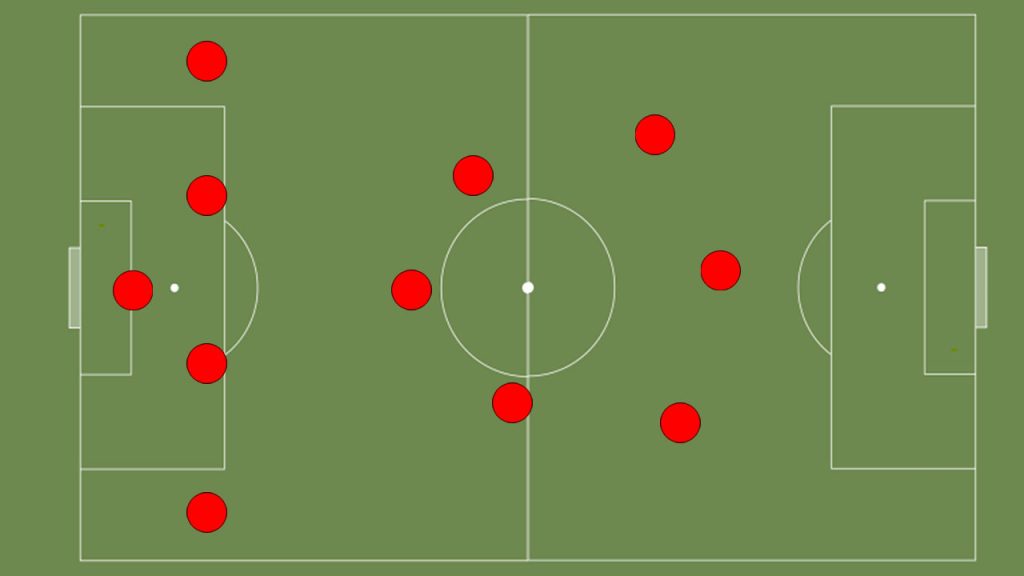
The 4-3-3- formation is a good one to be attacking with. It has a strong back four and has a three-man midfield and they all can play with different tactics with both the defenders as well as the attackers.
Having three forward is a really good way to score goals with the center forward mainly used to stretch the opposition’s backline and allow the wider players to exploit the space that is left behind.
This is a formation that both Real Madrid and Barcelona have been known to use. The highlight of this formation is the wing players who have real speed and have the great technical ability to get past defenders while the midfielders in the center are great with possession and are usually good defenders.
Like nearly all other formations, the 4-3-3 system does need both the fullbacks (left and right back) to help and join in on the attack when their team has possession.
The fullbacks will need to be really fit as they will be asked to constantly go up and down the field for the duration of the 90 minutes.
They do have an important job, however, to not only support their midfield teammates but also link up with the wingers and create two on one situations so they can overlap and get into good crossing positions.
As they must support the attack, they have to be diligent enough to be able to cover all of their defensive responsibilities as well.
One of the best ways that the formation is used is that the manager will play the midfielders in a triangle. This essentially means that out of the three, two will be more advanced leaving one to sit deeper as a defensive midfielder or a CDM.
The player playing in the CDM role will be the one who is going to be the most defensive out of the three players. The best CDM players are great at tackling and be supremely fit to help out when their team loses possession.
He will act as a shield between the midfield and defense but be able to cut out the opposition attacks.
Because he does this, it gives greater freedom to the other two central midfielders to be more attack-minded because they know that they have back up behind them.
The two more attack-minded midfielders should be great passers, be good at dribbling and also be able to track back and help out defensively too.
The front three of the 4-3-3 is the pivotal point of this formation. Both wingers will usually find a lot of space for themselves and will often be in situations where they can use their pace and power to run at the opposition defenders.
They are crucial to this formation being a success and they should have the speed to burn, be able to make intelligent runs behind the defense, have a great one on one ability to get past players, and also be good at crossing and shooting at goal.
For teams that want goals, the 4-3-3 formation is one that is regularly used.
3. Most popular soccer formation – 4-2-3-1
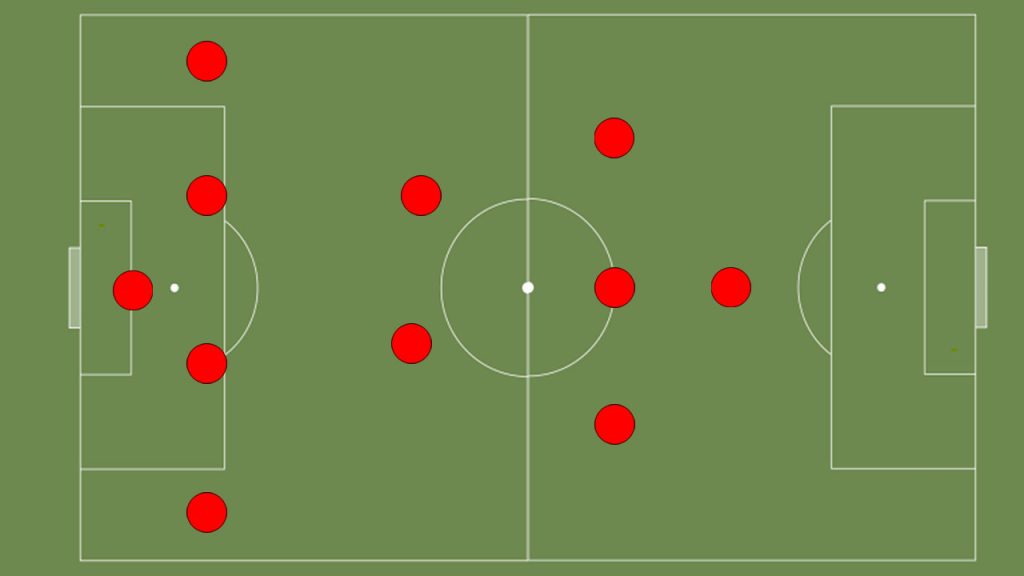
This formation involves four defenders, two defensive or holding midfielders, three attacking or creative midfielders, and the lone striker upfront. This formation is considered to be one of the most popular in the world today.
The back four ensures that their team is going to have enough width when they have possession but also when they do not.
The two defensive midfielders’ job is to cover the space that is in front of the back four and to close any pockets of space that the opposition might use to exploit the defense.
The three creative midfielders have the license to roam around and use their technical skills and link up with each other as well as the striker and can do it confidently as they have two players behind them for cover.
The striker is upfront by himself, however, he essentially has three other players around him to help out.
Whether that be linking up the play or providing crosses for the striker, this formation is designed to be very attack-minded but also had the defensive steel of the back four and the two defensive midfielders.
This formation is used but a lot of managers in today’s game. Both central defensive midfielders give the team balance as well as being far less predictable both in attack as well as defense.
They are the heartbeat of this system when the opposition has the ball as they cover the space and help protect the back four.
4. Best defensive soccer formation – 4-5-1
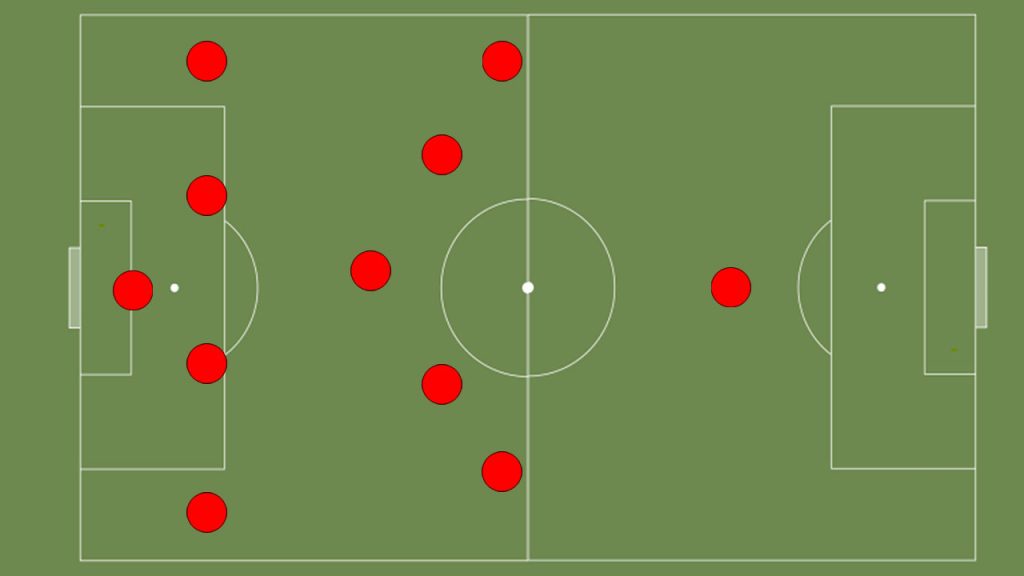
This type of formation gives a team more of a defensive look and it is suited to closing down the opposition’s style of play because there are two defensive midfielders in the center of the park.
The soccer players on the outside main responsibilities will not be getting forward and putting in crosses for the striker because the forward is going to be going against three or sometimes even four defenders.
This formation will usually only be used if a team has a shock lead in a match or if they are coming up against a team that is significantly better than them and has a really aggressive attacking style of play (think Liverpool v Sheffield United).
The players that are being used in this formation all should have great communication skills to prevent there being an abundance of players in the midfield area and that will in turn create outnumbers of the defenders and leave them exposed.
This type of formation is really hard for the opposition to break down because there is usually no space to work with for the attacking team.
If the score is 0-0 then it can perhaps be moved around a bit as the team is still thinking about the possibility of scoring on the counterattack and that will leave some gaps for the attacking team to exploit.
However, if the defending team has managed to sneak a goal then they have something to protect and all of their attacking instincts will now be out the window and they will focus all their energy on defending their lead.
This can make it really tough for an attacking team to break them down because essentially there will be 9 or every 10 players behind the ball to help defend and to clog up space.
5. Most used soccer formation in the Premier League – 4-4-2
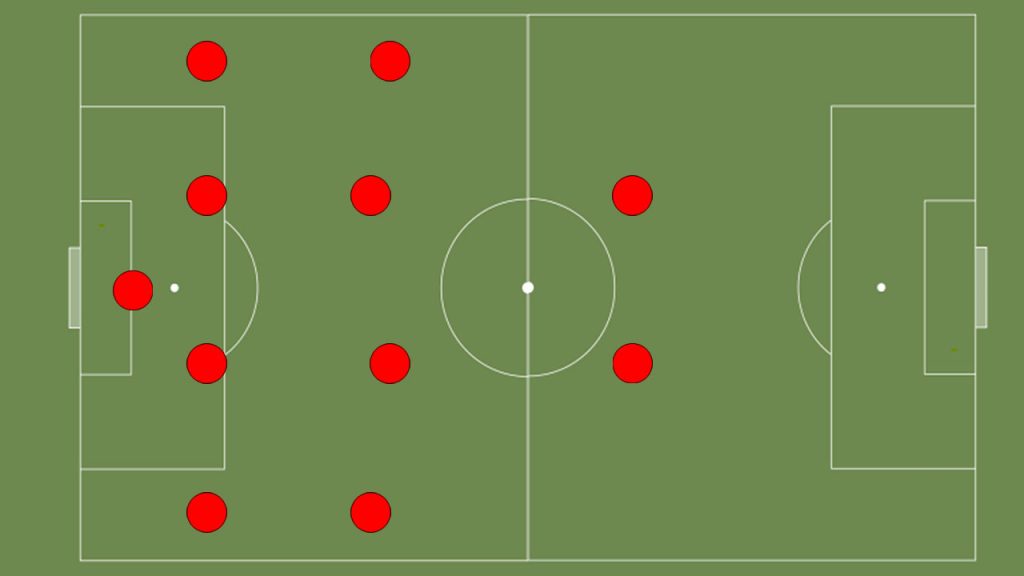
This formation is becoming increasingly fashionable in England’s topflight. This diamond system is sometimes known as the 4-1-2-1-2 formation and is bringing back the glory days of two striker systems.
On occasions, the system does not look like it should, and this is because the number 10 player will only play through the middle and then one of the striker’s jobs is to cover one of the wide areas on the pitch.
So when the team starts to attack, the formation looks out of whack, however in this modern age when tactics are incredibly flexible, the 4-4-2 diamond formation gives managers a lot of different options.
This is because the player roles are not defined, and the players do not have to stay in one restricted spot during a game.
Both the central midfielders and strikers can play both wide and narrow and the number 10 can basically go anywhere on the pitch while the fullbacks can either go forward or hold their defensive positions.
There is a downside to this formation though. It is that due to the lack of width because of the formation, there might be some situations where pockets of space happen.
An example of this is if the right-back decides to go forward, the central midfielders must be tactically aware to then drop and cover the back position, if they are unaware and the ball gets turned over, then there will be plenty of space for the opposing team to exploit.
6. Most effective soccer formation used by a Premier League Champion – 3-4-3 Chelsea 2016-17 season
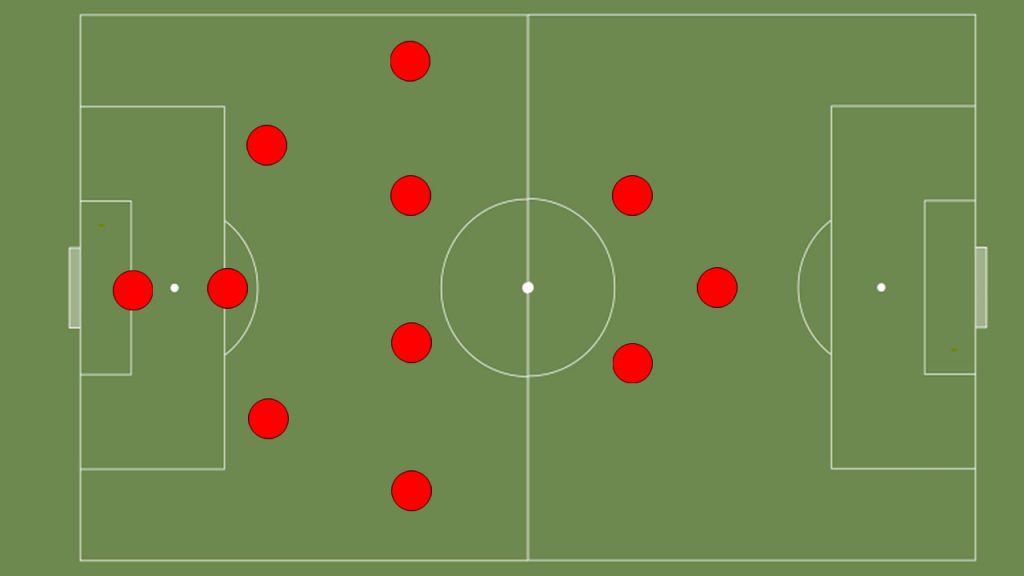
This formation completely changed Chelsea’s fortunes when Antonio Conte became manager. They broke all kinds of records on their way to the title in 2016-17. Back three formation has now become a lot more common in England and it has many benefits.
One is that it helps create outnumber situations when going forward and it also promotes a free-flowing, fluid attacking style of soccer while at the same time, being able to easily transition to a 5-4-1 when the team does not have the ball.
Because of the outnumbered situations it creates, the opposition will find it next to impossible to try and mark players and at the same time, it means that the wider areas are going to be a lot harder to exploit when the team does not have possession too.
On top of this, the central areas of the soccer pitch are always well covered with up to four players being able to shift defensively and help out if one of the fullbacks gets caught on the counter because they were upfield.
There is a main weakness however and that is just how physically demanding the formation is on the players.
The midfielders and wide players will need to be constantly running up and down the field for 90 minutes and that is why N’Golo Kante was such an integral part of this Chelsea team, because of his ability to get up and down the pitch.
It also needs the wingbacks (left back and right back in advanced positions) to be extremely disciplined when it comes to their defensive duties, however not so much that they do not attack either.
The main purpose of this formation is to create outnumbered situations going forward thanks to the wingbacks and there is hardly another formation that relies so much on a single position.
If both the full-backs are not fit enough to constantly go up and down the pitch then the formation will cease to function properly.
On the other side of that, if the backs are pushed upfield too high, then that is when the back three can be exposed.
This formation is perfectly suited for players and managers who want to play attacking football and if the wing-backs are fit enough and have enough tactical knowledge then this can be one formation that is hard to deal with.
7. Best soccer formation to use against a strong team -4-5-1
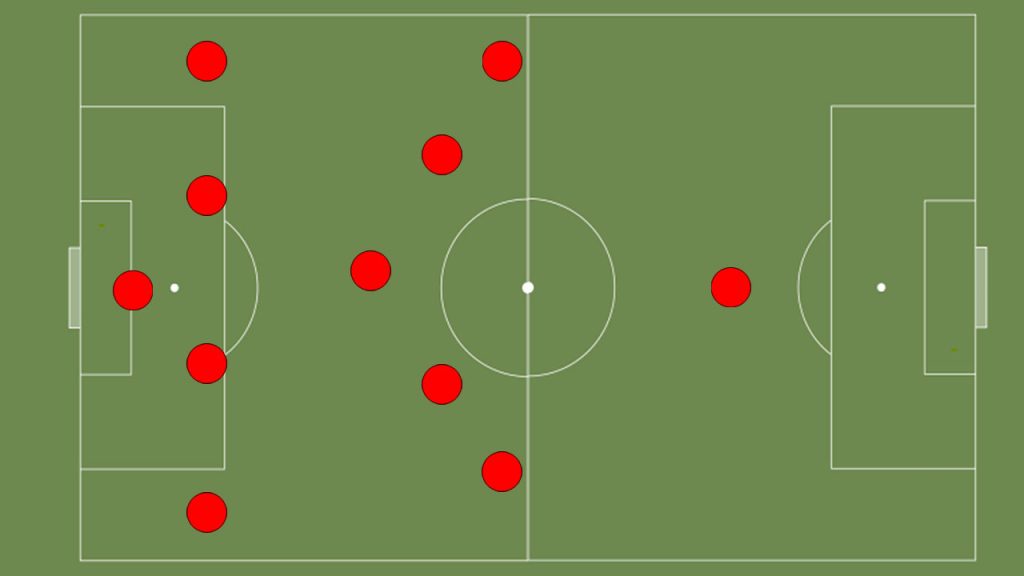
The midfield battle is something that can ultimately decide who wins and who loses a match, so if your side is facing a much stronger opposition then you will want to win the midfield battle. You can do this with this formation but overload the midfield area with your midfielders, 5 of them to be exact.
It is very defensive however with the 4-5-1 formation the midfield battle can be far easier to win and give your struggling side a fight chance against one of the big guns in the competition.
8. Best soccer formation to use against a weak team – 4-2-3-1

This is because it gives the side essentially four attacking players while having two defensive midfielders to cover the back four.
By having four attacking players, there is a real chance that throughout the game, someone is going to be one on one with a defender. The formation is well balanced and has both defensive solidities as well as attack prowess.
The three attacking midfielders and strikers can all operate together with freedom as they know that there are two defensive-minded players behind them.
9. Least used soccer formation – 2-3-5
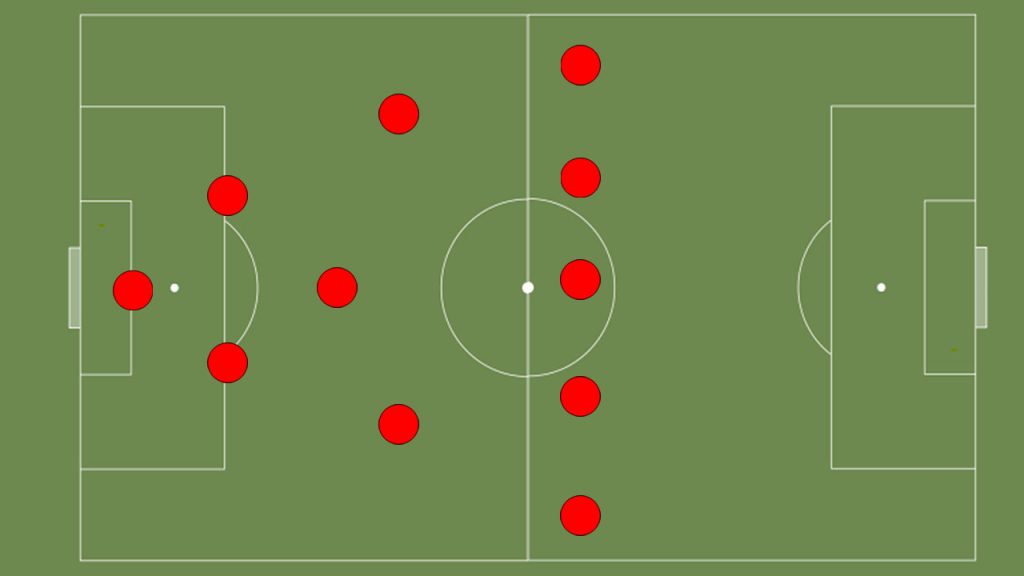
Yes, you did see that correctly, two defenders, three midfielders, and five attackers. This was the default formation way back in the 1880s and games were simply full of goals as you can imagine with only two defenders and five attackers.
It was quickly phased out as teams did not like how easy it was to be scored against and it has hardly been seen in the last 100 years, for obvious reasons.
10. The best soccer formation statistically – 4-2-3-1
It is essentially the best formation out there. It uses four defenders with two defensive players in midfield, three attacking midfielders, and a lone striker.
It also uses the diamond midfield formation of the 4-4-2 system to give teams strength in their midfield and limits the weaknesses of not having any wingers in the team at all. It scores the most goals and concedes the least.

